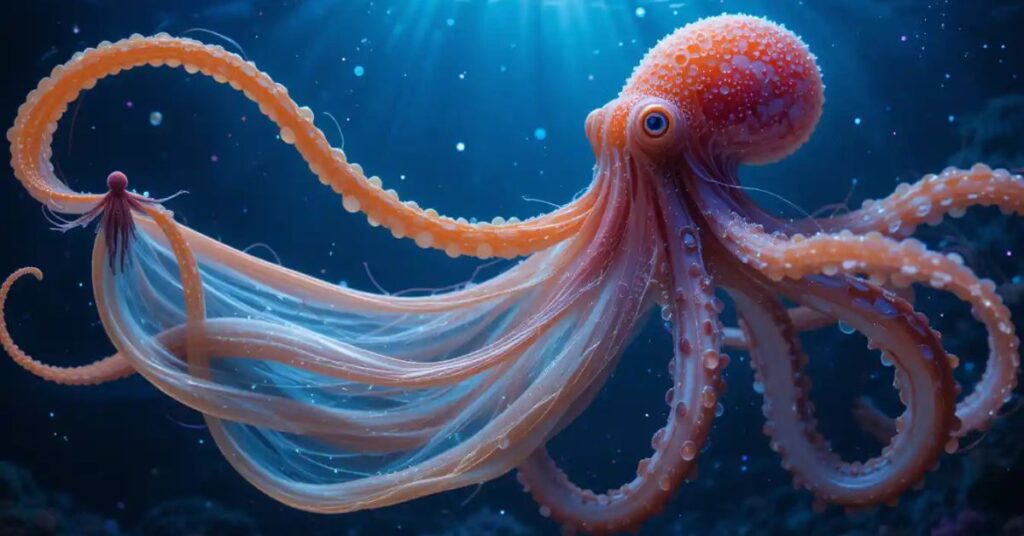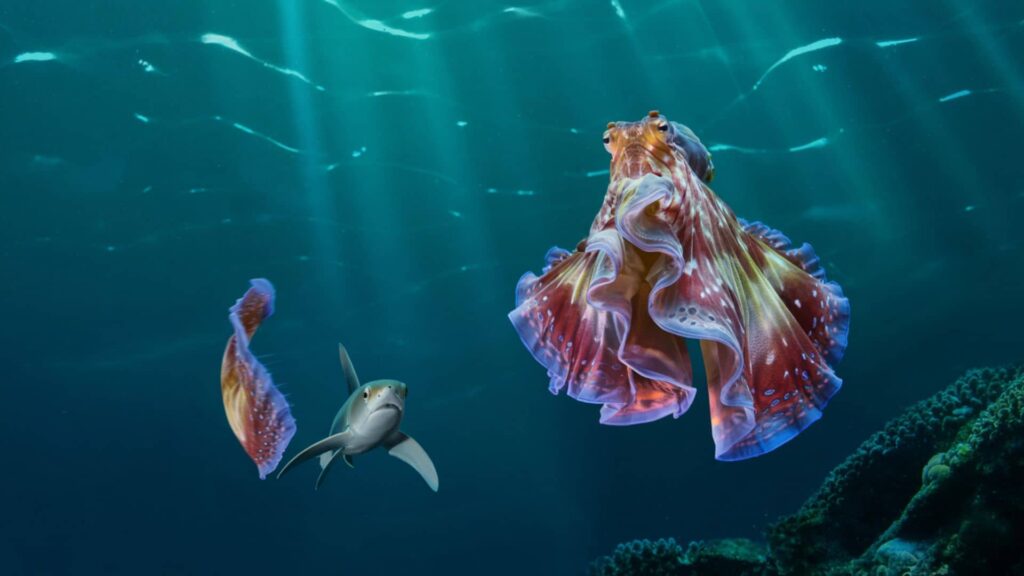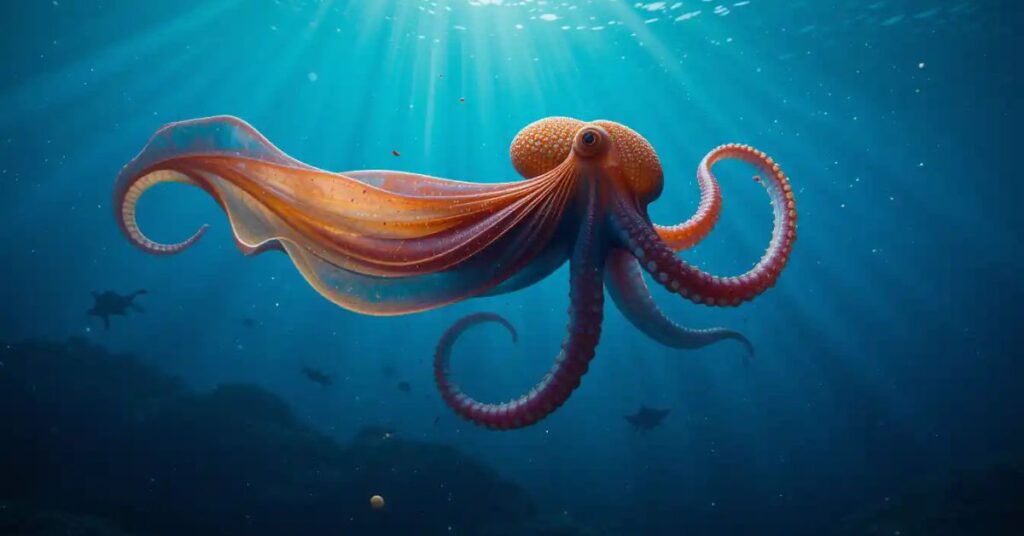Blanket Octopus Male vs Female — Tiny Males, Giant Females!

In the deep blue world of the ocean, few creatures are as fascinating — or as dramatically different — as the Blanket Octopus. Known for its stunning appearance and remarkable behavior, this marine marvel exhibits one of the most extreme examples of sexual dimorphism in the animal kingdom. That is, males and females of the same species are drastically different in size, shape, and even function.
But what really sets the Blanket Octopus male and female apart? This article explores their physical characteristics, roles in reproduction, behavioral traits, and evolutionary adaptations, all written in easy-to-understand language and guided by professional insights.
Meet the Blanket Octopus — An Ocean Enigma!
The Blanket Octopus (Tremoctopus spp.) is a pelagic species, which means it lives in the open ocean rather than along the coast or seafloor. These octopuses are rarely seen, partly due to their elusive lifestyle and deep-water habitat. Yet, when spotted, they leave an unforgettable impression.
Especially the females, which trail long, flowing, web-like membranes between their arms — a feature that earned them their name. These elegant “blankets” give the animal a majestic, almost mythical presence in the water.
Do You Know? Heardle 60s: A Fun Music Game for 1960s Song Lovers!
Male vs Female: A Look at the Differences
Let’s begin with a side-by-side comparison to get the essentials out of the way.
| Aspect | Female Blanket Octopus | Male Blanket Octopus |
|---|---|---|
| Size | Up to 2 meters (6.6 feet) long | About 2.4 cm (less than 1 inch) |
| Weight | Can weigh over 10 kilograms | Weighs less than 1 gram |
| Appearance | Bright colors, blanket-like arms | Plain, no blanket |
| Behavior | Active swimmer, predator | Stealthy, focused on reproduction |
| Defense Mechanism | Spreads blanket, startles predators | Uses Man o’ War tentacles defensively |
| Reproductive Role | Stores sperm, lays eggs | Uses detachable arm (hectocotylus) |
| Lifespan | Much longer than males | Short-lived, dies after mating |
A Size Gap That Stuns Scientists:
One of the most jaw-dropping facts about the Blanket Octopus is the size difference between the sexes. Females are up to 40,000 times larger than their male counterparts. To put that into perspective, if a woman were the same proportionally larger than a man, she would be the size of a blue whale while he’d be a house cat.
This disparity is one of the most extreme known in nature — not just among octopuses, but across all animal species.
Take Analysis To:Retro Bowl Unblocked 77– Play Football Anytime, Anywhere!
Why Are Blanket Octopus Males So Small?
This isn’t a case of nature being unfair — it’s nature being efficient. In the open ocean, reproduction is key, and males have evolved to specialize in it. Instead of growing large and powerful, the male Blanket Octopus has one primary mission: to find a mate and deliver his genetic material.
He does this using a specialized arm called the hectocotylus, which is essentially loaded with sperm. When he meets a female, he detaches this arm and leaves it with her. She can store the arm — and the sperm — until she’s ready to fertilize her eggs.
It’s a one-shot deal. After mating, the male usually dies shortly afterward. A short life, but a purposeful one.
The Female’s Role — Larger, Longer, and More Dramatic!

Females, by contrast, live longer and have a more complex role. Not only do they lay and protect the eggs, but their large size and flowing blanket give them an edge in predator defense and hunting.
Their blanket is more than decorative. It can be unfurled to make the octopus appear much larger, frightening off predators like sharks or larger fish. And if all else fails, she can detach part of the blanket, distracting the threat while she escapes.
Evolutionary Adaptations — Specialized for Survival!
Over millions of years, both sexes of the Blanket Octopus have evolved to play specific, optimized roles:
- Males have minimized their body size to reduce energy consumption and increase mobility. This helps them survive just long enough to reproduce.
- Females have developed dramatic visual adaptations — like the shimmering blanket — to outwit predators and thrive in their open-ocean environment.
These are brilliant examples of evolutionary specialization, where the differences aren’t random but deeply functional.
Defensive Tactics — The Portuguese Man o’ War Trick!
Here’s where it gets even more fascinating. Male Blanket Octopuses (and some small juveniles) have been seen ripping off tentacles from the deadly Portuguese Man o’ War jellyfish and wielding them like weapons.
These jellyfish have tentacles filled with venomous stingers, which the octopus uses to fend off attackers. Thanks to natural immunity to the stings, the male can use them safely — like a sword fighter with a jellyfish whip.
Life Cycle and Reproductive Strategy:
The entire reproductive process is highly specialized:
- The male locates a female, often by detecting chemical cues in the water.
- Once close, he extends his hectocotylus arm, filled with sperm.
- This arm is inserted into the female and then detaches.
- The male dies shortly after — a phenomenon known as semelparity.
- The female keeps the arm until she’s ready to fertilize her eggs, which she carries under her arms.
- After laying thousands of eggs, she too may die — completing the life cycle.
Why Sexual Dimorphism Matters?
In marine biology, extreme sexual dimorphism like this raises interesting questions. Why didn’t both sexes evolve to be large and strong? The answer lies in energy allocation. For a species that lives in the vast, resource-scarce pelagic zone, it’s more efficient for one sex to focus on survival and reproduction (female), while the other focuses solely on genetic transfer (male).
This difference reduces intraspecific competition and allows both sexes to thrive in their own evolutionary niches.
How do the behaviors of male and female blanket octopuses differ?
Female Behavior:
- Defensive Strategies: Uses its large, flowing “blanket” to appear bigger and intimidate predators.
- Weaponized Defense: Can detach and wield stolen jellyfish tentacles (from Portuguese man o’ war) for defense.
- Active Hunters: Hunts small fish, crustaceans, and jellyfish in open waters.
- Intelligent and Adaptive: Displays complex behaviors, including problem-solving and mimicry.
- Egg Care: Carries and protects over 100,000 eggs until they hatch.
Male Behavior:
- Short-Lived and Mating-Focused: Primary goal is to find a female for reproduction.
- Small and Stealthy: Uses camouflage and agility to avoid predators.
- Hectocotylus Mating Strategy: Transfers sperm via a detachable arm (hectocotylus), which stays with the female.
- Minimal Defense: Lacks the large blanket-like webbing of females and relies on jellyfish tentacles for protection.
- Brief Lifespan: Dies shortly after mating, as it does not engage in extended survival strategies like females.
Must Check: Sean Kyle Swayze – The Untold Story!
Are blanket octopuses dangerous to humans?
Blanket octopuses are not considered dangerous to humans. They are elusive, deep-sea dwellers that prefer open ocean waters, making encounters with people extremely rare. Unlike some other octopus species, they do not possess venomous bites or strong beaks capable of harming humans.
While females can use stolen jellyfish tentacles as a defense mechanism, this behavior is primarily aimed at deterring predators rather than posing any threat to humans. Overall, blanket octopuses are fascinating yet harmless marine creatures that prefer to avoid confrontation rather than engage with potential threats.
Also Read: Codes Etruesports — Unlocking the Future of Gaming!
Where do blanket octopuses live?

Blanket octopuses inhabit warm tropical and subtropical oceans, thriving in deep, open waters far from the coastline. Unlike many other octopus species that live on the ocean floor, they are pelagic, meaning they spend their entire lives swimming freely in the open sea.
They are often found at midwater depths or near the surface, drifting with ocean currents in regions such as the Atlantic, Pacific, and Indian Oceans. Their ability to navigate vast oceanic spaces helps them avoid predators and find food, making them well-adapted to life in the deep blue.
FAQs About Blanket Octopus Male vs Female:
1. Why is the female Blanket Octopus so much larger than the male?
Because of reproductive roles and survival strategies — females need size for defense and carrying eggs, while males focus only on reproduction. This extreme size difference is known as sexual dimorphism, and it’s one of the most dramatic examples found in nature.
2. What is the “blanket” in Blanket Octopus?
It’s a large membrane between the female’s arms, used to scare predators and enhance appearance. When fully extended, it creates a dazzling visual display that can startle predators and confuse threats.
3. Do male Blanket Octopuses really use jellyfish tentacles as weapons?
Yes! They’ve been observed using tentacles from Portuguese Man o’ War as a defense mechanism. This shows a rare example of tool use in invertebrates, demonstrating impressive adaptability.
4. How does reproduction work in Blanket Octopuses?
The male detaches a sperm-filled arm into the female. She stores it and later uses it to fertilize eggs. This unique process allows the female to fertilize her eggs at the most advantageous time.
5. Why do males die after mating?
They are semelparous — meaning they reproduce once and then die, maximizing reproductive success. This ensures all their energy is dedicated to finding and mating with a female, without holding anything back.
6. Where do Blanket Octopuses live?
They’re found in tropical and subtropical oceans, often in the Atlantic and Pacific pelagic zones. Since they live far from shore, sightings are rare, adding to the mystery surrounding their lives.
Conclusion:
The blanket octopus is one of the most amazing creatures in the ocean. The huge difference between males and females makes them truly unique. Females can grow very large and use jellyfish tentacles as weapons, while tiny males live only to mate and then die.
Even though they look unusual, blanket octopuses are not dangerous to humans. They prefer to live in the open ocean, far from people. Scientists are still learning more about these mysterious animals, and as we discover more, we can better understand their role in the ocean.
Latest Post:
- B0clxwrt1n – Mystery Behind the Digital Enigma!
- PR-AD-48-760-35ZMHY – A Game-Changer for Industry and Sustainability!
- SWA 12626 XE Burwood, Melbourne, Australia – A Prime Area for Work!






